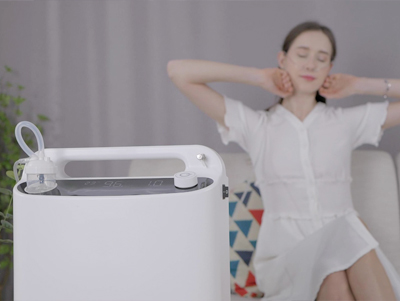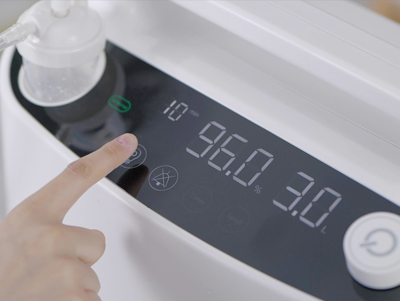30 Jun 2023
Home oxygen concentrators utilize advanced technology to extract and deliver concentrated oxygen to patients. These devices operate by taking in ambient air and filtering out other gases, leaving behind oxygen-rich air for inhalation. A typical home oxygen concentrator consists of key components such as an air compressor, sieve beds, a compressed air chamber, and a delivery system. By utilizing this technology, home oxygen concentrators ensure a continuous and reliable supply of oxygen to patients.
Benefits of Home Oxygen Concentrators
Improved respiratory function and oxygen saturation levels:
Home oxygen concentrators offer a significant advantage by enhancing respiratory function and maintaining optimal oxygen saturation levels in the body. This is crucial for individuals with chronic respiratory conditions, such as chronic obstructive pulmonary disease (COPD) or emphysema, as it helps alleviate symptoms and improve overall well-being.
Enhanced quality of life for individuals with respiratory conditions:
By delivering a steady supply of oxygen, home oxygen concentrators enable individuals to engage in daily activities with increased ease and comfort. Patients can experience reduced shortness of breath, improved energy levels, and better sleep, allowing for a more fulfilling and active lifestyle.

Independence and mobility for patients:
Unlike traditional oxygen therapy methods that rely on bulky oxygen tanks, home oxygen concentrators offer the advantage of mobility and freedom. With portable options available, patients can move around their homes, travel, and engage in various activities without being constrained by the need for large oxygen tanks.
Convenience and Comfort
Compact and portable designs:
Many modern home oxygen concentrators are designed to be compact and lightweight, ensuring convenience and ease of use. These devices can easily fit into small spaces, making them suitable for both home and travel use. The portability factor allows patients to maintain their therapy regimen without feeling limited by their condition.
Noise levels and operation simplicity:
Home oxygen concentrators are designed to operate quietly, minimizing disturbances for patients and their households. Additionally, these devices are user-friendly, with intuitive interfaces and straightforward controls. Patients can easily adjust their oxygen flow rate and monitor their oxygen saturation levels, ensuring personalized and efficient therapy.

Cost-Effectiveness
Comparison with traditional oxygen therapy methods:
Home oxygen concentrators provide a cost-effective alternative to traditional oxygen therapy methods, such as compressed or liquid oxygen tanks. Unlike tanks that require frequent refills and deliveries, concentrators generate oxygen on-demand, eliminating the need for replenishments and associated costs.
Long-term savings for patients:
Investing in a home oxygen concentrator can result in long-term savings for patients. By reducing the reliance on costly oxygen tank refills, concentrators offer a more sustainable and economical solution. Over time, the savings can be significant, making home oxygen concentrators a practical choice for individuals requiring long-term oxygen therapy.
Safety Features and Considerations
Oxygen purity and delivery accuracy:
Home oxygen concentrators undergo rigorous testing to ensure the delivery of high-purity oxygen to patients. Oxygen purity levels are typically monitored, and alarms are in place to alert patients of any fluctuations. Moreover, concentrators provide accurate oxygen delivery, ensuring patients receive the prescribed amount of oxygen.
Maintenance and safety precautions:
Regular maintenance and adherence to safety guidelines are crucial for the optimal performance and safety of home oxygen concentrators. It is important for patients to follow recommended maintenance schedules, clean the device as instructed, and store it appropriately. Consulting healthcare professionals and manufacturers' guidelines can provide further guidance on safety practices.
Selecting the Right Home Oxygen Concentrator
To choose the most suitable home oxygen concentrator, patients should consider their specific oxygen requirements and consult healthcare professionals. Factors such as prescribed oxygen flow rate, portability needs, and additional features should be taken into account when selecting a device. Healthcare professionals can provide valuable insights and recommendations based on individual needs, ensuring patients receive the most effective therapy. Micitech has a variety of medical grade oxygen concentrators to meet all your needs.
Conclusion
The advantages of home oxygen concentrators make them an indispensable tool in respiratory care. By improving respiratory function, enhancing quality of life, and offering convenience, these devices have transformed oxygen therapy for patients with respiratory conditions. With the cost-effectiveness, safety features, and portability they offer, home oxygen concentrators are a valuable resource for individuals seeking to reclaim their independence and breathe easier. It is important for patients to explore the options available and consult healthcare professionals to find the right home oxygen concentrator that meets their unique needs.
Keywords: oxygen concentrator
Originally published 30 Jun 2023, updated 30 Jun 2023.